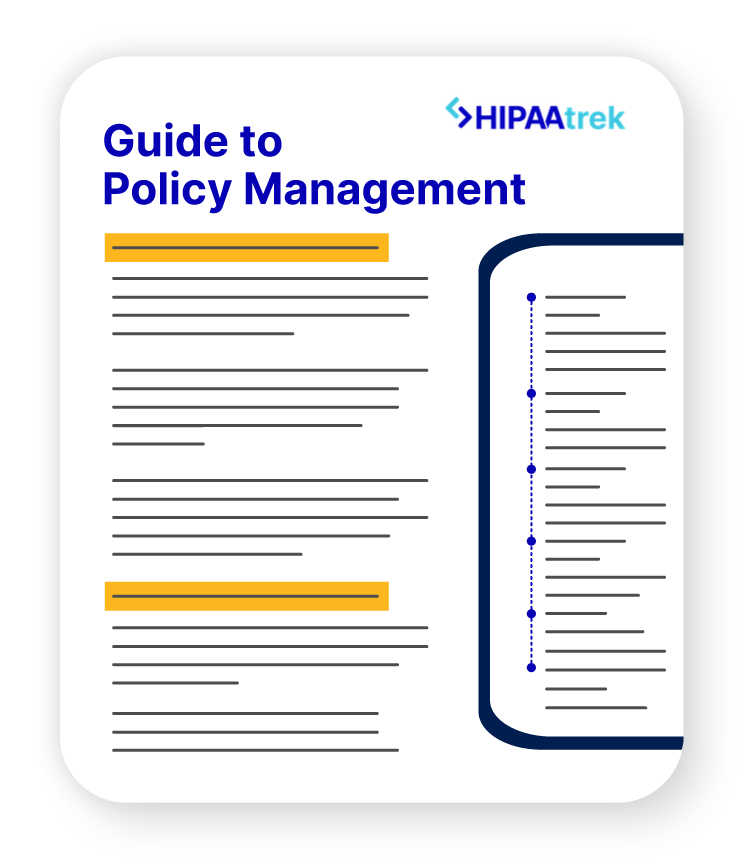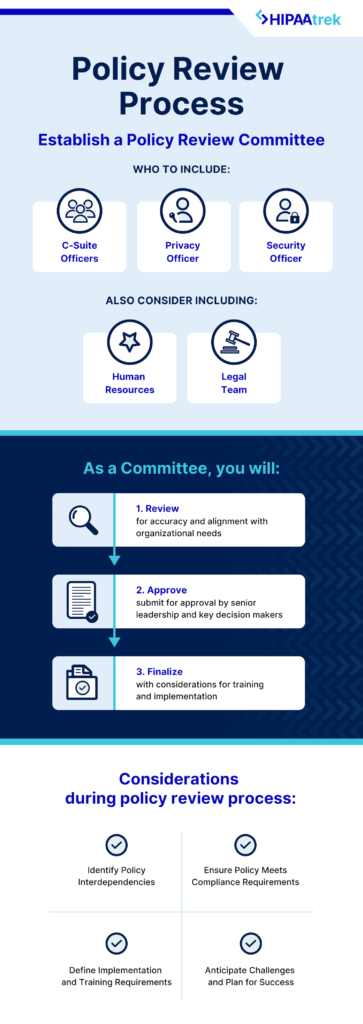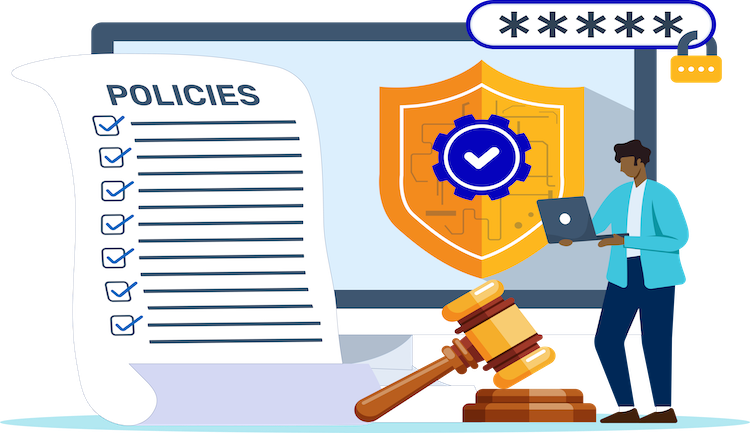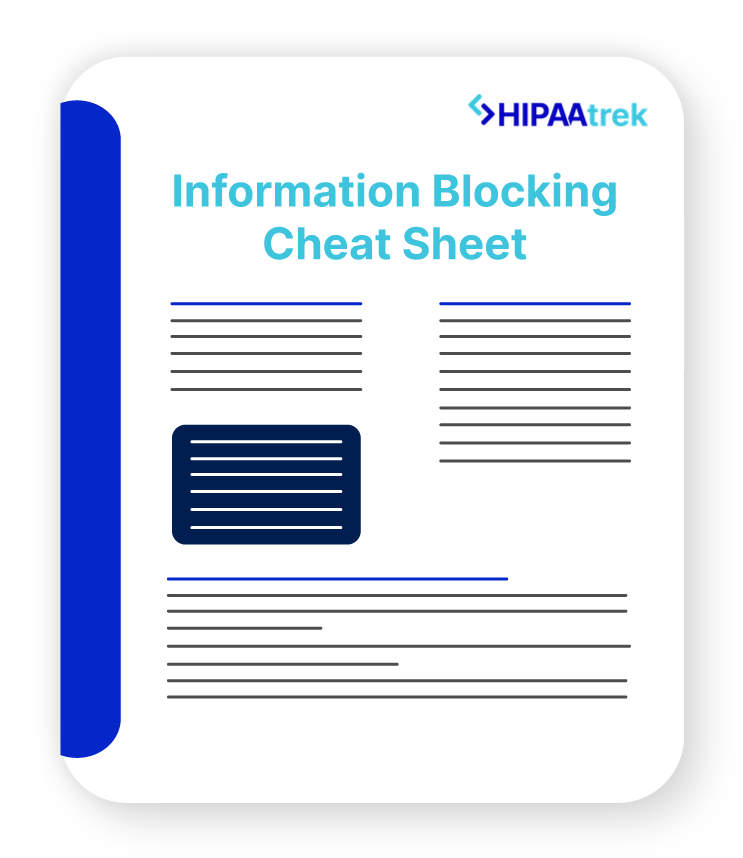Policies are the backbone of your HIPAA compliance program, but that doesn’t mean that you’re done once you have policies in place! Unfortunately, they aren’t a “set-it-and-forget-it” thing.
Your HIPAA policies require regular policy management, including reviews, updates, and documentation of implementation steps. Today, we’re clarifying the steps you can take to manage your policies and feel confident that they are creating a strong foundation for your HIPAA compliance.
Want to follow along? We made you a downloadable Policy Management Workflow to keep you on track. Click here to download it now:

Need More Help? Grab Our Guide to Policy Management!
Policy management can be overwhelming, so we’ve created this workflow to help you get started.
Now, let’s dive into policy management:
HIPAA Policy Management Requirements
Under HIPAA, Covered Entities (CEs) are required to have policies and procedures, and to review them periodically. Within the HIPAA regulations, certain requirements for these policies are outlined, like the requirement that they outline safeguards for PHI.
But what exactly is a policy under HIPAA? Understanding what policies are, the role they play in your compliance program, and how they are different from procedures is critical before we dive into policy management.
Policies define the why: they provide the guiding principles, ethics, and overall framework that dictate your organization’s approach to compliance, operations, and culture. They outline what needs to be done but do not specify the exact steps for doing it. Policies set the expectations for behavior and decision-making.
Procedures define the how: they outline the specific, actionable steps required to implement policies. Procedures provide the detailed instructions necessary to carry out the policy consistently, with a focus on execution to ensure that policies are followed correctly.
In our work with Covered Entities, we often see these two confused or conflated. Policies set the direction, while procedures outline the exact steps to follow. Without clearly distinguished procedures, staff don’t know how to implement policies. That means they risk creating gaps in governance, making it harder to ensure consistency and compliance.
The other mistake we often see around policies is when organizations treat policies as nothing more than a restatement of the HIPAA regulations. A policy shouldn’t just be a copy of the rules—it should serve a purpose.
Policies guide your organization’s decisions and actions, serving as a roadmap for your ethics, culture, and compliance efforts. If all you have is a regulation written down, it won’t help you navigate challenges or determine the right corrective actions when something goes wrong.
Compliance Policy Management Process
Now that you understand what a policy is and is not, you’re ready to dive into policy management. As with most processes we outline on the HIPAAtrek blog, we suggest starting with risk analysis.
Risk Analysis
HIPAA requires that CEs perform a Security Risk Analysis (SRA) to address known risks. But beyond the HIPAA requirement, risk analysis is key to building a strong foundation for your entire compliance program. After all, you can’t chart a course without knowing where you’re starting.
Begin your policy management process with risk analysis, so that your policies can directly address identified risks and include clear guidance on how to mitigate them, tailored to the specific needs of your organization.
Once you’ve conducted a risk analysis and identified potential vulnerabilities, you can use those insights to update and refine your policies accordingly.
For example, a common deficiency in many organizations is the failure to conduct an Application and Data Criticality Analysis (ADCA)—a key step in identifying how critical each application is to maintaining the confidentiality, integrity, and availability of sensitive data. Without this analysis, an organization may be vulnerable in the event of a system failure or security breach.
If your risk analysis uncovered this gap, you could develop a policy outlining the necessity of the ADCA, highlighting specific requirements for conducting it, and ensuring that contingency planning aligns with regulatory requirements.
Centralizing Policy Storage
In healthcare, there isn’t a single method for documenting and storing policies—organizations use various approaches. What is consistent across CEs, however, is the HIPAA mandate that all staff have access to their organization’s policies.
Meeting this requirement can take many forms. Some organizations use shared drives, while others rely on policy management software. Ideally, organizations are moving away from outdated paper manuals, which pose various risks—physical damage, loss, theft, or misplacement can compromise sensitive information and leave organizations vulnerable to compliance risks.
Most organizations now follow best practices and maintain digital documentation, but even that comes with challenges. If policies are stored as Word documents, there’s a risk that staff could accidentally edit or delete them.
To prevent this, many organizations convert policies into PDFs, but managing updates this way can be cumbersome. PDF storage can be inflexible, making it easy for policies to become outdated. Given how quickly privacy and security requirements evolve, it’s critical to ensure staff always have access to the most current versions.
A platform like HIPAAtrek simplifies this process by keeping policies up to date, easily accessible, and aligned with compliance requirements. In fact, every new HIPAAtrek client undergoes a thorough policy assessment as a part of their HIPAAtrek onboarding, to be sure policies are up-to-date with the latest regulations. The entire updating and approval process can be managed and tracked in HIPAAtrek, and policies can even be assigned to staff for review. Learn more about our Policy Module here.
Policy Review Process
The Office of Civil Rights (OCR) requires regular reviews of HIPAA policies, with industry best practice recommending an annual review, but the review process can feel overwhelming.
What exactly does a policy review involve? Beyond simply reading through documents, it requires a thorough evaluation of how policies align with regulations, impact other policies, and translate into day-to-day operations. A structured review approach ensures that updates are accurate, actionable, and effectively implemented across the organization.
Establishing a Policy Review Committee
A structured policy review process ensures that the right people are involved in approving and finalizing policies before they are implemented. Without a clear workflow for policy sign-off, there’s a risk that critical decisions could be made in isolation by departments, without input from key stakeholders. This can create gaps in compliance, oversight, and governance.
A best practice is to establish a policy committee responsible for reviewing and approving policies before they are finalized.
At a minimum, the C-suite Officers, Privacy Officer, and Security Officer should be part of the policy committee to maintain proper oversight. In many cases, HR and legal teams should also participate, since certain policies may have implications for workforce training, employee rights, or regulatory compliance. Having the CEO, CFO, or other senior leaders involved ensures that policies align with the organization’s broader strategic goals and risk management efforts.
While the exact structure may vary by organization, the approach for the policy committee should include the following steps:
- Review – The policy committee evaluates proposed or updated policies to ensure accuracy, compliance, and alignment with organizational needs.
- Approve – Policies are submitted for approval by senior leadership, ensuring they meet both regulatory and operational requirements.
- Finalize – Before implementation, policies must be formally approved by key decision-makers, including the Privacy Officer, Security Officer, and C-suite executives.
A well-defined policy review process not only strengthens compliance but also ensures that policies are practical, enforceable, and aligned with the organization’s overall mission.
Other actions your policy committee should take when reviewing policies include:
1. Identifying Policy Interdependencies
When updating or creating a policy, it’s important to consider how it connects to other policies and processes within the organization. A single policy rarely exists in isolation—changes to one can have a ripple effect on others.
For example, if the policy committee is reviewing an update to the contingency plan, it’s critical to assess how it impacts related policies, such as emergency mode operations, physical security, and technical safeguards.
Any references to other policies within the document must also be updated to maintain consistency and ensure alignment across all compliance efforts.
2. Ensuring Accuracy in Regulatory Compliance
Every policy must be reviewed to confirm that it accurately reflects current regulatory requirements. If a policy is updated due to a change in regulations or an internal risk analysis, the committee should carefully check that all necessary provisions are included and that nothing critical has been overlooked.
Regulatory misalignment can lead to major organizational risks, so this step is essential to ensure that policies fully meet HIPAA and other legal requirements.
3. Defining Implementation Requirements
A policy isn’t effective unless it can be put into practice. This is where procedures play a big role. The policy committee must identify what implementation will look like in day-to-day operations.
This includes considering who the key stakeholders are, what processes may need to be adjusted, and whether additional training is required. The policy should outline clear expectations and provide the necessary guidance for employees.
4. Anticipating Challenges
Implementing a revised policy can create challenges, such as resistance to change, resource constraints, or logistical hurdles in updating existing workflows.
To mitigate these risks, the policy committee should establish a clear process for rolling out the updated policy, including steps for communicating changes, training relevant staff, and ensuring ongoing compliance.
Simply reading and approving a policy is not enough—there must be a structured approach to integrating it into daily operations to ensure it serves its intended purpose.

Policy Implementation
It’s critical to track and follow policies consistently. This means creating clear processes for documenting when and how policies are being implemented and ensuring that this documentation is audit-ready.
The HIPAAtrek team categorizes policies into three groups, allowing us to prioritize implementation.
- Ongoing Tasks: Some policies require recurring tasks. For example, policies around data encryption or access controls may need to be checked or updated regularly. To ensure compliance, organizations should set reminders or tasks for these ongoing duties and document the completion of each task.
- As-Needed Tasks: Other policies, such as those related to disclosures, may only be enacted when specific situations arise. For instance, if a public health department requests patient information for a public safety issue, policies for disclosure must be followed. For these types of policies, it’s essential to create guidance materials for employees to follow when the need arises. These materials can serve as evidence of the policy in action, helping demonstrate compliance during audits.
- Training-Only Policies: Some policies may not require specific actions beyond employee training. These are typically policies that focus on creating awareness or reinforcing best practices, rather than requiring continuous or situational tasks. In these cases, implementation is focused on ensuring that staff members understand the policy and are adequately trained to follow it.
The Importance of Training
Training is an extension of policy implementation. For your organization to effectively follow its policies and procedures, you must ensure that staff are properly trained.
General training, like HIPAA 101, is not sufficient, because these types of training lack specificity and don’t teach employees how to follow your organization’s unique policies.
To be effective, training should be role-based and tailored to individual responsibilities. For example, a doctor doesn’t need to be trained on the process of releasing medical records if it’s not part of their job; instead, Health Information Management (HIM) staff should be trained on that specific procedure.
Role-specific training also reduces training fatigue. Employees are human and when training materials are too general or abstract, it’s easy to tune it out. By focusing on relevant, role-specific information, your staff will better understand how to apply policies in their work, to improve compliance and ensure that policies are actively followed.
HIPAA Policy Management
Policy management is foundational to the success of your compliance program. Without policies that are specific to your organization, you’re stepping in the dark, hoping you’re doing the right thing, but you could be putting your organization at risk.
While policy management can be overwhelming, HIPAAtrek’s platform can help. HIPAAtrek makes it easy to centralize, maintain, and share your policies. Not only that, but with over 70 built-in policy templates, the system provides users with a head start. Plus, with automated version control, every update is tracked and ready to share in case of an audit.
And don’t forget, if you want to remember the lessons of this blog post, we made you a downloadable Policy Management Workflow to keep you on track. Click here to download it now:
Need More Help? Grab Our Guide to Policy Management!
Policy management can be overwhelming, so we’ve created this workflow to help you get started.













